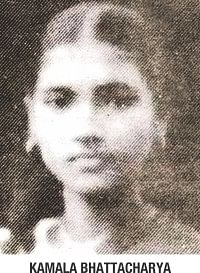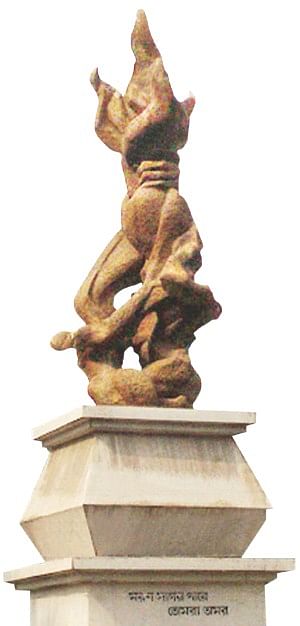From the Archives: The valley of sacrifice
As we prepare to commemorate the sacrifices of some brave young Bangalees in that defining y ear of 1952, we cannot but bear in mind some other realities. Bangalees also in other regions -- India's Barak valley and Manbhum -- have lost their lives protesting assaults on their language. How many of us are aware of such hard truths? Today, we recount those tales of commitment and valour.
ear of 1952, we cannot but bear in mind some other realities. Bangalees also in other regions -- India's Barak valley and Manbhum -- have lost their lives protesting assaults on their language. How many of us are aware of such hard truths? Today, we recount those tales of commitment and valour.
A river is called Barak. A date frozen in the calendar is May 19, 1961. In the morning that day, when the world woke up to celebrate the birth centenary of its poet-laureate, Rabindranath Tagore, the two banks of Barak rose to an wake up call to defend its legitimate right to sing in Tagore's language, to dream in Tagore's words, to live a Bangalee life. In the railway track of the district town, Silchar of the then undivided district of Cachar of Assam, ten young men and a woman fell down to the bullets of the state police.
That young woman, aged only 16, is Kamala Bhattacharya, the youngest and the first woman language martyr of the world.
Barak Valley was a rather newish christening for erstwhile Cachar district. This tract of land in the southern periphery of Assam is home to about four million people, 80 percent of them speak Bangla and spread over the three districts of Cachar, Karimganj and Hailakandi.

Language, it is a known fact, is the Achilles' Hill in the whole of the northeast India where the process of building sub-nationality has, for the last one hundred years or so, veered around language apart from ethnicity. The historical sequence started with the assertion of Assamese nationalism during the dawn of the twentieth century which was pitted against the Bangla-speaking community out of paranoia. The British colonial design was the mastermind behind sowing the seeds of anti-Bangalee sentiments among the Assamese middle class. Economic factors further aggravated the deprivation theory which continued throughout the remaining part of the pre-colonial and also well into the post-colonial Assam.
The fear psychosis that the Bangalee domination would not only close the avenues of employment for the Assamese youth, but, more than that, would surely destroy the Assamese language and culture drove the political rulers of Assam to take anti-Bangalee steps on numerous occasions. And the worst of it happened in 1960 when the Assam Government passed the nefarious Official Language Act, making Assamese the only official state language other than English. The people of the then Cachar district went all out in protest against this Act the provisions of which they rightly felt would deprive them of their legitimate linguistic right. It was a mass upsurge and the chauvinist Assam Government came down heavily on the democratic movement. Situation went to a grave pass when on 19 May 1961 police resorted to firing on unarmed Satyagrahis in Silchar Railway Station that left eleven people dead.
In the face of more intensified democratic agitation aided by popular support from all over the country, the Assam Government finally yielded. In that year itself suitable amendment was brought in to the Official Language Act 1960, accommodating Bangla as the official language for the whole of Cachar district.
But, unfortunately, the xenophobic mindset of the State Government did not change and, as a result, clandestine designs of infringing on the linguistic right of the Bangalee of Assam have remained unabated in the state. On 17 August 1972, one more language activist laid down life in Karimganj in protest against the circular of Gauhati University which sought to make Assamese the only medium of instruction in the state colleges.
On 21 July 1986, two more brave souls sacrificed their lives in Karimganj during a protest against the draconian Board of Secondary Education of Assam circular which struck down Bangla as one of the media of instruction in the state school education.
On 16 March 1996, one woman activist embraced martyrdom in the Valley for the cause of her mother tongue, Bishnupriya Manipuri.
This territory of Barak Valley thus has a glorious tradition of language movement spanning a half-a-century period.
As for Kamala, the day after her matriculation exams ended, a picketing was being organised in Silchar railway station demanding Bangla as the medium of education. So, after taking her bath Kamala wore a sari of her elder sister Pratibha and prepared to go picketing. Her elder sister warned her of possible dangers. In the meanwhile, a group of 20-22 girls came to their house to take her. They alleviated her mother's concerns and took Kamala along with them. Kamala's mother gave her a piece of cloth to defend herself from teargas. Kamala's younger sister Mangala, younger brother Bakul and her nephew Bappa too accompanied the group.
The rail blockade passed off peacefully in the morning. In the afternoon, the Assam Rifles began to arrive at the railway station. Around 2:35pm the paramilitary police started beating the protesters with rifle butts and batons without any provocation from them.
Hit by the police, Kamala's younger sister fell to the ground and began crying for help. The police had opened fire on the protesters by then. As Kamala rushed to the rescue of her sister, a bullet pierced through her eye and hit her head. Kamala was taken to hospital where she died.
Unconscious Mangala too was admitted to hospital, where she regained her consciousness after one month. She became mentally unstable for the rest of her life.
In 2011, marking the golden jubilee of the sacrifice of 19 May 1961, a bronze bust of Kamala Bhattacharya was unveiled on the premises of the Chhotelal Seth Institute.
Sources: Eisamay, unishemay.org and other Indian sites.